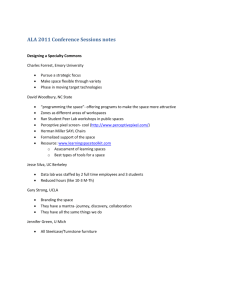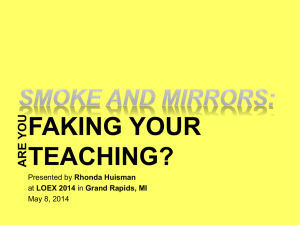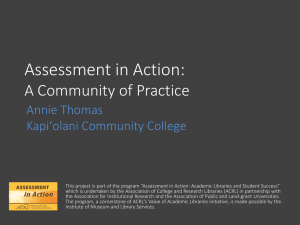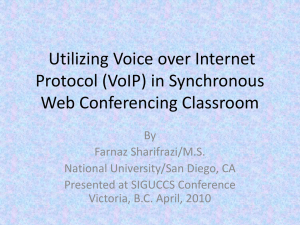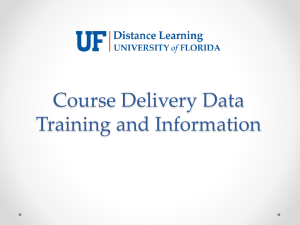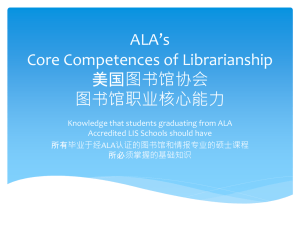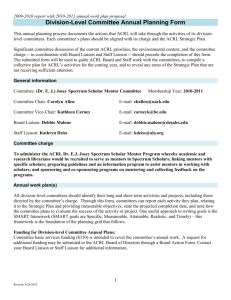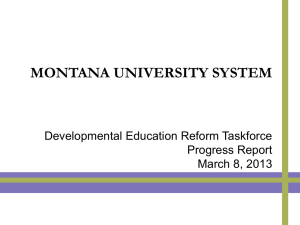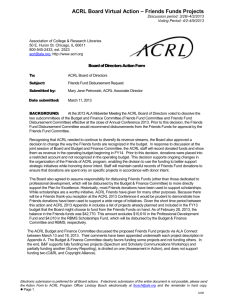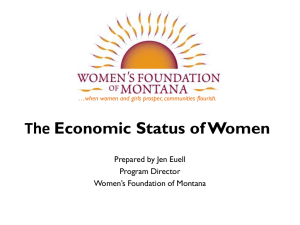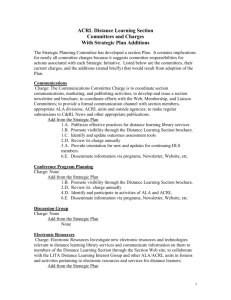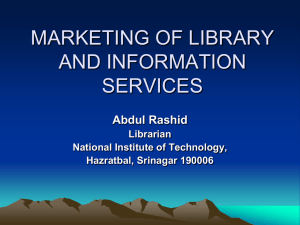Library Instruction Live! - American Library Association
advertisement
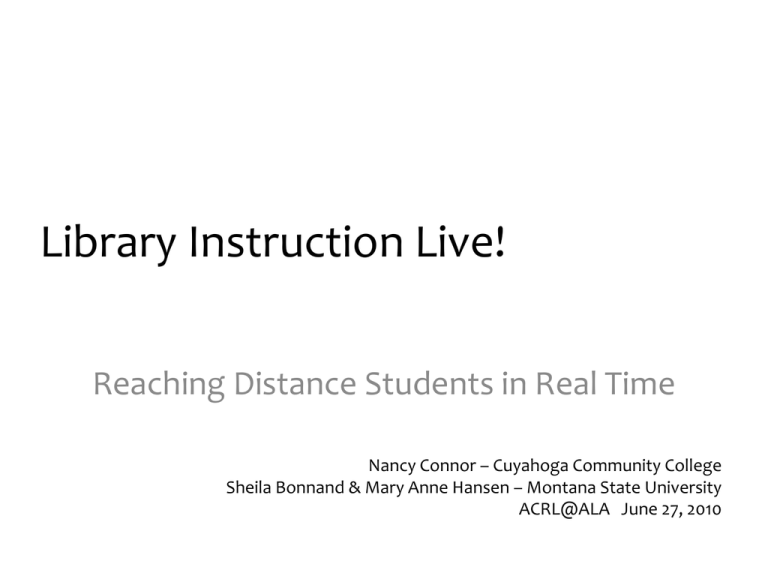
Library Instruction Live! Reaching Distance Students in Real Time Nancy Connor – Cuyahoga Community College Sheila Bonnand & Mary Anne Hansen – Montana State University ACRL@ALA June 27, 2010 Objectives • • • • • • Distance Learning & Library Instruction Asynchronous vs. Synchronous Learning Web Conferencing Our Experiences & Best Practices Live Demonstration Questions, Comments, Feedback “Every student, faculty member, administrator, staff member, or any other member of an institution of higher education, is entitled to the library services and resources of that institution, including direct communication with the appropriate library personnel, regardless of where enrolled or where located in affiliation with the institution. Academic libraries must, therefore, meet the information and research needs of all these constituents, wherever they may be.“ ACRL GUIDELINES FOR DISTANCE LEARNING SERVICES: THE ACCESS ENTITLEMENT PRINCIPLE "Guidelines for Distance Learning Library Services," American Library Association, September 01, 2006. http://www.ala.org/ala/acrl/acrlstandards/guidelinsdistancelearning.cfm (Accessed February 24, 2009) Document ID: 185689 ACRL Guidelines for Distance Learning Library Services Philosophy: A Bill of Rights for the Distance Learning Community • Access for Achievement of Superior Academic Skills • Direct Human Access • Mandated Support • Institutional Involvement of Library & Other Personnel • Meeting Needs, the Primary Responsibility • Outcomes Assessment • Information Literacy • • • • • • Library web sites Subject guides Course specific web sites Internet tutorials Email LMS’s ASYNCHRONOUS LIBRARY SERVICES SYNCHRONOUS LIBRARY SERVICES • • • • • Instruction Collaboration Support Socialization and informal exchange Extended outreach (Finklestein, p. 3) • • • • • • Comfort Safety Personalization Proximity Autonomy ? WEB CONFERENCING • our experiences • best practices Prescreen Welcome screen Screen Share Collaboration Screen How do you rate the quality of the technology = 4.21 How do you rate the quality of the instruction = 4.52 How would you rate the overall experience = 4.47 Survey http://spreadsheets.google.com/viewform?hl=en&formkey=dEd2Zl9rWmpVSnpNVjg 5NkRQODJFV2c6MA..#gid=0 “It was incredibly helpful, I don’t feel lost using the virtual library anymore. I’m definitely glad to know all of the advantages of it now.” “I really enjoyed this, thanks for making it available this way. Furthering my education is important especially when I can do it at home with my family in my PJ’s.” TRI-C STUDENT FEEDBACK “I liked this a lot! It was cool and kind of futuristic and fun! “ “Nice way to have students interact.” “Having the session recorded was the only way for my attendance, and it was very informative and helpful. Technology is a bit overwhelming for me and Ms. Connor made it easy to follow. Thank you.” “The overview of library resources was excellent and I have already accessed some resources as a result of the session. “I was impressed with how helpful this service will be.” “I have not used the MSU library for any of my previous courses simply because the web-site looks so daunting. Most of my fears have been laid to rest. Thanks!” MSU STUDENT FEEDBACK “I love being able to see the computer screen in the demonstration.” SHOW & TELL http://breeze.tri-c.edu/ala/ WHERE DO WE GO FROM HERE? Chakraborty, Mou and Shelly Victor. “Do’s and Don’ts of Simultaneous Instruction to On-campus and Distance Students via Videoconferencing.” Journal of Library Administration. 41.1-2 (2004): 97-112. Finkelstein, Jonathan E. Learning in Real Time: Synchronous Teaching and Learning Online. Jossey-Bass, 2006. Gokhale, Pratibha. “E-Learning and the Role of Libraries.” Information Studies. 15.2 (2009): 67-74. Graham, John-Bauer. “An Uneven Balancing Act: One Library Administrator’s View on Providing Library Services for Distance Patrons.” Journal of Library & Information Services in Distance Learning. 3.2 (2009): 43-46. Henning, Mary M. “Closing the Gap: Using Conferencing Software to Connect Distance Education Students and Faculty.” Journal of Library Administration. 31.1/2 (2001): 233-246. Hines, Samantha S. “How It’s Done: Examining Distance Education Library Instruction and Assessment.” Journal of Library Administration. 48.3 (2008): 467-478. Kontos, Fotini and Harold Henkel. “Live Instruction for Distance Students: Development of Synchronous Online Workshops.” Public Services Quarterly. 4.1 (2008): 1-11. Lietzau, Julie. “Breaking Out of the Asynchronous Box: Using Web Conferencing in Distance Learning.” Journal of Library & Information Services in Distance Learning. 3.3/4 (2009): 108-119. Mathews, Brian S. “Socially Driven Instruction: Developing Learning Encounters Online.” Journal of Web Librarianship. 3.3 (2009): 273-277. Pival, Paul R. and Johanna Tunon. “Innovative Methods for Providing Instruction to Distance Students Using Technology.” Journal of Library Administration. 2.1/2 (2001): 347-360. Scales, Jane and Lara Cummings. “Web Conferencing Software.” Library Hi Tech News. 26.9 (2009): 7-9. Thomsett-Scott, Beth and Frances May. “How May We Help You? Online Education Faculty Tell Us What They Need from Libraries and Librarians.” Journal of Library Administration. 49.1-2 (2009): 111-135. RESOURCES Sheila Bonnand, Assistant Professor/Reference Librarian, Montana State University Library, PO Box 173320, Bozeman, MT 59717-3320, (406) 994-4130, sbonnand@montana.edu Nancy Connor, Librarian/Associate Professor, Cuyahoga Community College, 2900 Community College Avenue, Cleveland, OH 44115, 216.987.4314, Nancy.Connor@tri-c.edu Mary Anne Hansen, Associate Professor/Reference Librarian, Montana State University Library, PO Box 173320, Bozeman, MT 59717-3320, (406) 994-3162, mhansen@montana.edu CONTACT US
